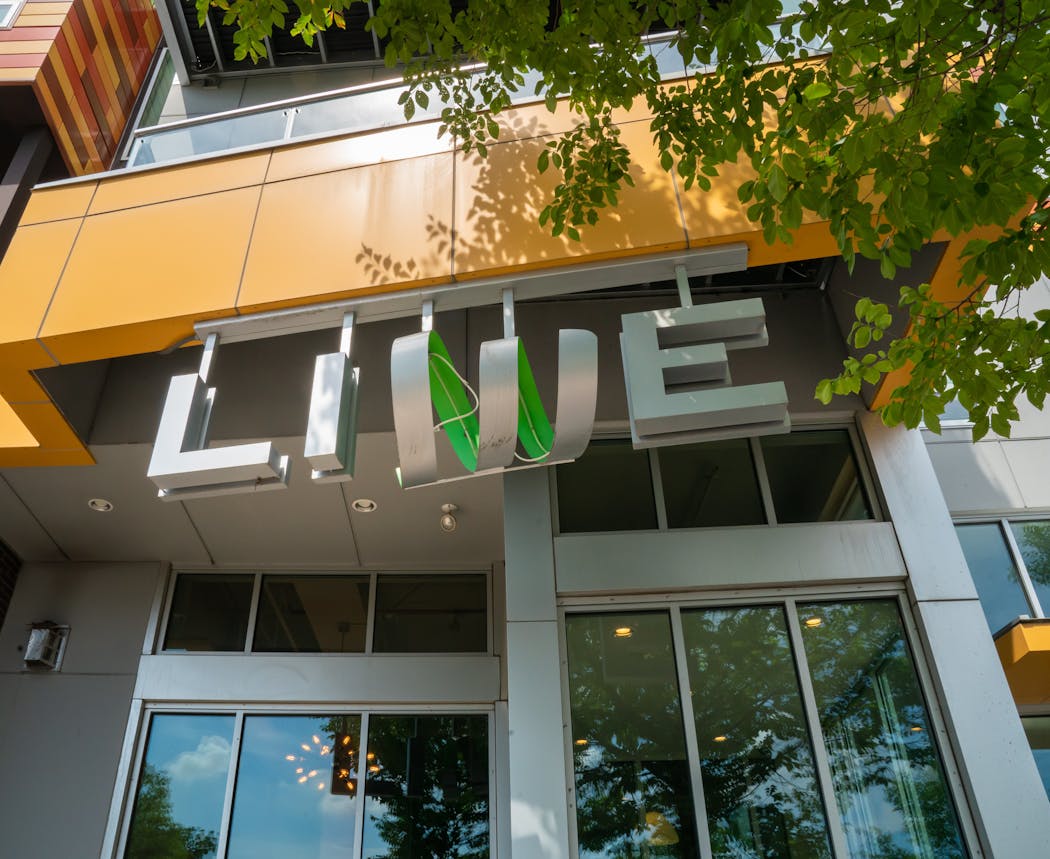Why is a red building called Blue? Who is the Julia? Would you rather live in Flux or O2?
In the past two decades, countless modern, glassy multifamily mid-rises have cropped up among the Twin Cities' historic brick-and-brownstone apartment buildings. And the complexes' names have evolved with the times, from stately and straightforward to quirky and catchy. Yesterday's Belvedere, Belmont or Humboldt Terrace is today's Elan, Revel, Viridium or Hello.
"Names that are on the offense, from a marketing standpoint, are probably more appealing to that millennial renter demographic," said Josh Brandsted, president of Minneapolis-based apartment developer Greco.
Amid a booming Twin Cities multifamily housing market — in the past five years, developers have built about 30,000 new apartment units — an edgy name serves as an "icebreaker," Brandsted said, and helps differentiate a new complex from its competitors.
The name of one recent Greco-developed building — Variant, a white-brick structure that looks nothing like its North Loop neighbors — was selected to literally suggest it's different from its peers.
"There are a lot of similarities in these projects in how they look, and how the units are designed, and the feel to them," Brandsted explained. "So on the outset of that project we said, 'We've got to do something different, something that stands out.' "
Each of Greco's many apartment buildings has a unique personality, Brandsted said. "They live and they breathe just as if they were a person."
Hence, the latest branding trend among local apartments: giving your building a person's first name. Not only are Odin and Asher the names of your hip friends' young sons, but a couple of new Minneapolis apartment buildings.
Telling a story
When planning a new multifamily building, Minneapolis-based Sherman Associates, like many local developers, often turns to a site's location and history to inspire a name that will give the project a unique position in the market.
After an initial "namestorm," Sherman winnows the list to a small group of finalists, which they check for copyright infringement and website domain name availability, explained Valerie Doleman, a senior vice president who helped formalize the company's naming process.
A group then scores each name based on various factors, from its ease of pronunciation and recall to its ability to be represented visually.
"The name helps build brand loyalty and it can help tell a story," Doleman said. "You don't want to get cliché. You don't want it to feel like a corporate waffle-type name where it would prompt a sarcastic response."
Some of the names Sherman selects have layers of meaning, Doleman said. For example, the company will soon begin construction on a project in downtown Minneapolis named O2, in reference to the symbol for oxygen, to reflect the design's emphasis on well-ventilated air and honor the existing fire station that will be rebuilt.
Before Sherman broke ground for a forthcoming property in north Minneapolis, they invited their neighbors at Juxtaposition Arts to help them come up with the name. The result — Beam — suggests the developer's desire for the building to be both a sound, enduring fixture and a beacon of light in the neighborhood, Doleman said.
"Where you live defines you," she added. "So people are saying, 'Do I want to be part of this story?' "
Brandsted, Greco's president, said that prospective residents often say a building's name piqued their curiosity enough to motivate a tour.
An example: Blue, in the Lyn-Lake area, a building which is, in fact, red in color.
"People always ask, 'Why is it red?' " Brandsted said. "And the response is always, 'So that you talk about it.' " (The second answer is that Blue was meant to evoke the building's eco-friendly design, Brandsted added.)
Flux, another building that Greco developed in Uptown, was intended to reflect the life stage of many of its residents, as they try out various careers, relationships and lifestyles before settling down. "Flux is kind of the mantra of the target demographic for that building," Brandsted said. "They're kind of living their life in flux."
And Greco's colorful Lime, in Lyn-Lake, was meant to create a sense of synergy with the area's eclectic mix of shops and people. Its spunky marketing campaign — "Fresh squeezed" "In the limelight" — plays off the zesty name, Brandsted said.
While residents don't base their decision to move on a name, a memorable moniker can't hurt when some prospects tour so many properties that they arrive with spreadsheets to compare their pros and cons.
"You want people talking about your project and remembering your project when they're going out and they're looking at 10, 15, 20 different buildings," Brandsted said.
A personal connection
While names that incorporate a building's neighborhood or street number can help with wayfinding and online search, they don't do much to convey a building's unique vibe.
That's one reason "first name" buildings, which have a friendly and approachable feel, have become a popular way to make an emotional — almost personal — connection.
Minneapolis-based developer Curt Gunsbury, founder of Solhem Companies, was an early adopter of this trend. In late 2018, Gunsbury opened the Julia in northeast Minneapolis, named after his grandmother. He followed that project with the brand-new Lucille and Frances, also named after family members.
The decor of each building reflects the personality of each woman, he explained: "western hipster intellectual" for Julia; "sophisticated, restrained and worldly" for Lucille; "party girl who loves dogs" for Frances. And the distinct personalities help foster a sense of community among residents.
As for the future, Gunsbury said he thinks dog names have good potential, for their warmth and intimacy. "I could definitely see Doug, Spencer or Lily on a building," he said.
Rachel Hutton • 612-673-4569


